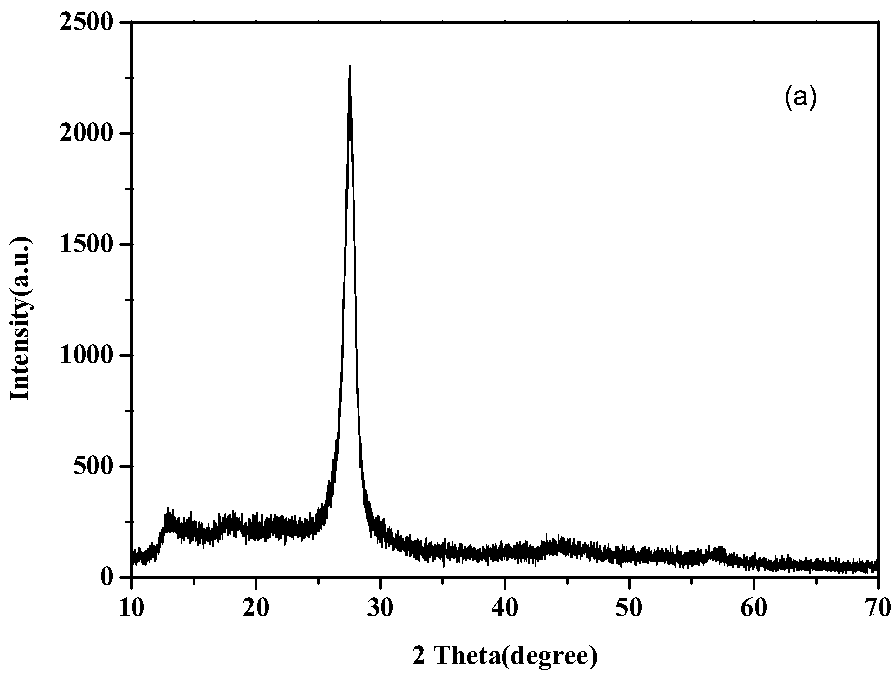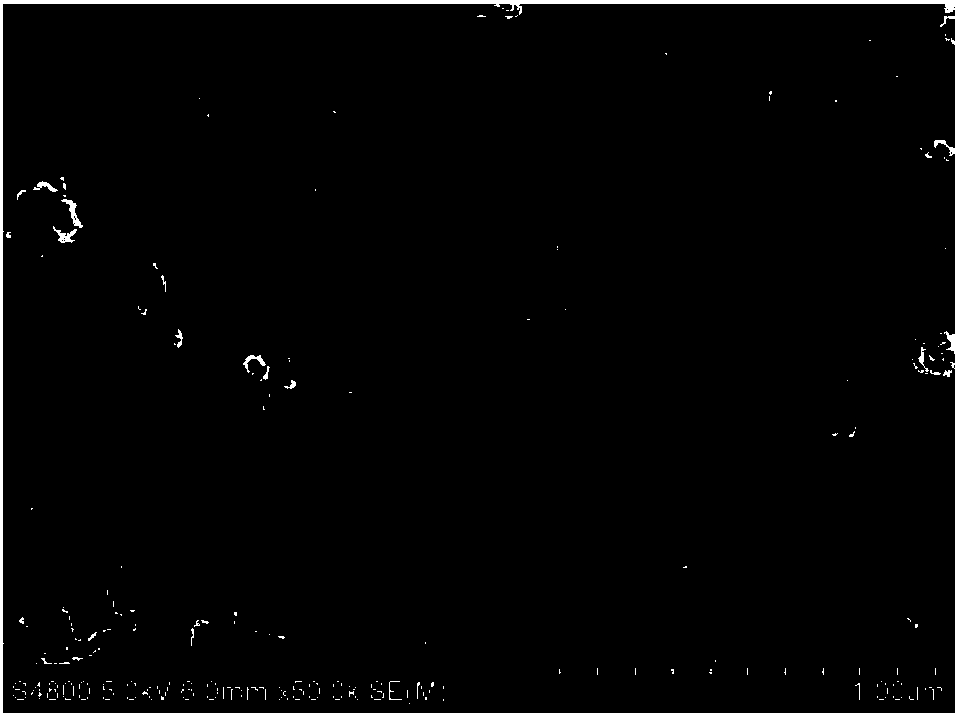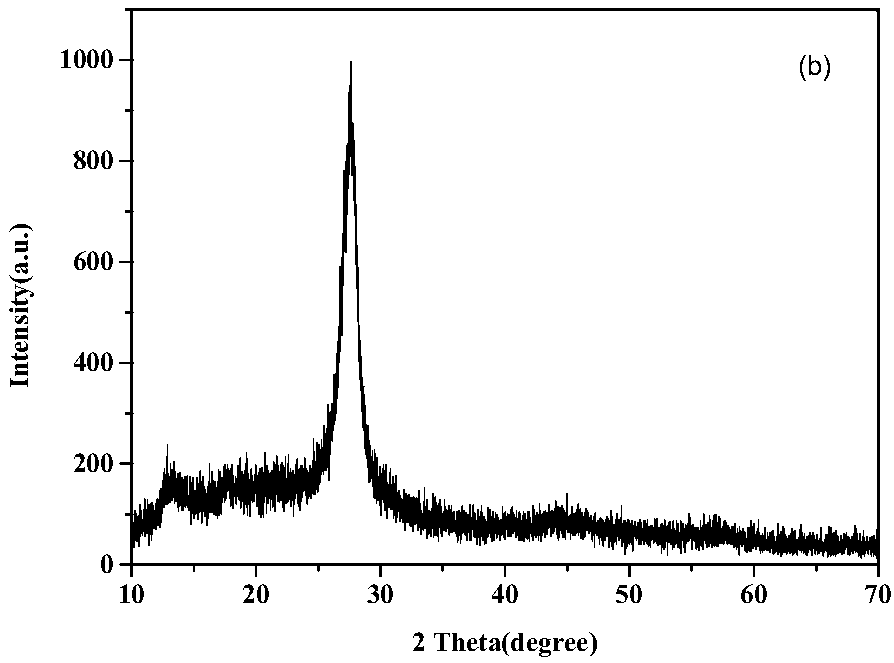Porous g-C3N4 (graphene-carbon nitride) photocatalyst as well as preparation method and application thereof
A photocatalyst, g-c3n4 technology, applied in the field of photocatalytic materials, can solve the problems of application limitation, low surface area, and low photocatalytic efficiency, and achieve the effect of reducing recombination rate, large surface area, and small specific surface area
- Summary
- Abstract
- Description
- Claims
- Application Information
AI Technical Summary
Problems solved by technology
Method used
Image
Examples
Embodiment 1
[0023] Example 1 Pure g-C 3 N 4 catalyst of light
[0024] (1) Preparation method
[0025] 1) Take 2.52 grams of melamine and add it to an alumina crucible, transfer it to a tube furnace, and roast it at 550°C for 4 hours under nitrogen protection (the heating rate is 5°C.min -1 ), to obtain pure g-C 3 N 4 catalyst of light.
[0026] (2) Detection
[0027] figure 1 for pure g-C 3 N 4 XRD detection of photocatalyst samples. Depend on figure 1 It can be seen that two diffraction peaks appear at 13.1 degrees and 27.4 degrees, corresponding to g-C 3 N 4 (002) and (100) crystal planes, it can be seen from the figure that the sample has good crystallinity.
[0028] figure 2 for pure g-C 3 N 4 SEM examination of photocatalyst samples. Depend on figure 2 Visible, pure g-C 3 N 4 It shows a typical block structure, and the sample does not show the existence of pores in the scanning electron microscope image.
[0029] Figure 5 for pure g-C 3 N 4 Photocatalyst s...
Embodiment 2
[0030] Example 2 Porous g-C 3 N 4 catalyst of light
[0031] (1) Preparation method
[0032] 1) Add 2.52 g (0.02 mol) of melamine solid into 120 ml of deionized aqueous solution, stir in a water bath at 80° C. for 30 min until it is uniformly dissolved. Add 48 μL (0.0004mol) of acetaldehyde solution dropwise, and stir in a water bath at 80° C. for 2 h. Transfer to an oven and dry at 80° C. for 14 hours to obtain a white intermediate product.
[0033] 2) Grind the white intermediate product, put it into an alumina crucible, transfer it to a tube furnace, and roast it at 550°C for 4 hours under nitrogen protection (heating rate is 5°C per minute, nitrogen flow rate is 40ml min -1 ), to obtain g-C with amorphous carbon nanoparticles 3 N 4 powder.
[0034] 3) will have amorphous nano-carbon particles g-C 3 N 4 The powder was ground again, put into an alumina crucible, transferred to a muffle furnace, and fired at 550°C for 2h in an air environment (the heating rate was 5°...
Embodiment 3
[0039] Embodiment 3 modified precursor g-C 3 N 4 Applications
[0040] The porous g-C prepared in embodiment 2 3 N 4 Photocatalyst Conduct photocatalyst material performance testing.
[0041] The method is as follows: use a 300W xenon lamp as the light source, adjust the photocurrent to the position of 20mA, adjust the center of the light intensity to irradiate the sample surface, fix the position, and separate the pure g-C 3 N 4 and porous g-C 3 N 4 put in 4cm 2 In the glass tank, put the glass tank containing the photocatalyst into a 224ml reactor containing an atmospheric pressure air, and finally inject 10ul isopropanol liquid into the reactor, after 20min of light, draw the second needle, every 20 minutes Withdraw a needle, test, and record the peak area of isopropanol.
[0042] The result is as Image 6 As shown, after 20min of light, pure g-C 3 N 4 Catalyst degradation was 2109ppm, while the porous g-C 3 N 4 The catalyst degradation amount is 8854ppm, re...
PUM
| Property | Measurement | Unit |
|---|---|---|
| volume | aaaaa | aaaaa |
| volume | aaaaa | aaaaa |
Abstract
Description
Claims
Application Information
 Login to View More
Login to View More - R&D
- Intellectual Property
- Life Sciences
- Materials
- Tech Scout
- Unparalleled Data Quality
- Higher Quality Content
- 60% Fewer Hallucinations
Browse by: Latest US Patents, China's latest patents, Technical Efficacy Thesaurus, Application Domain, Technology Topic, Popular Technical Reports.
© 2025 PatSnap. All rights reserved.Legal|Privacy policy|Modern Slavery Act Transparency Statement|Sitemap|About US| Contact US: help@patsnap.com



